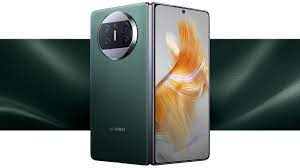
Table of Contents
Huawei’s latest innovation, the tri-fold smartphone, has recently resurfaced in the tech news, generating significant excitement and curiosity within the industry. This new device, which boasts a unique design that differentiates it from existing foldable smartphones, underscores Huawei’s ongoing commitment to pushing the boundaries of mobile technology. This article delves into the details of the tri-fold smartphone, its design features, potential market impact, and the broader implications for the foldable phone market.
The Evolution of Foldable Smartphones
Since the introduction of the first foldable devices, such as Samsung’s Galaxy Fold and Huawei’s Mate X, the industry has been on a quest to refine and perfect this innovative concept. These devices aim to combine the portability of smartphones with the expansive screen real estate typically associated with tablets.
The initial generation of foldable phones faced several challenges, including durability issues, high prices, and limited applications. However, each successive iteration has brought improvements in screen technology, hinge mechanisms, and overall design. Huawei’s tri-fold smartphone represents the latest advancement in this rapidly evolving field.
Unveiling the Tri-Fold Design
Huawei’s tri-fold smartphone, as the name suggests, features a tri-fold design, which sets it apart from the traditional single-fold or double-fold designs seen in other foldable devices. Here’s an overview of the unique aspects of this design:
- Three-Fold Mechanism: Unlike traditional foldable phones that typically fold once or twice, Huawei’s tri-fold design incorporates three distinct folding points. This allows the device to transform from a compact, pocket-sized phone into a larger tablet-like screen, offering users unparalleled versatility and screen space.
- Extended Display: When fully unfolded, the tri-fold smartphone reveals an expansive display that provides a more immersive viewing experience. The added screen real estate is ideal for multitasking, gaming, and media consumption, making it a compelling option for users who demand more from their devices.
- Compact Form Factor: Despite its ability to unfold into a larger screen, the tri-fold smartphone is designed to remain compact and portable when folded. This balance between a large screen and a pocketable size is a key selling point for users who value both functionality and convenience.
- Durability and Flexibility: One of the challenges with foldable phones has been ensuring the durability of the screen and hinge mechanism. Huawei’s tri-fold smartphone is expected to incorporate advanced materials and engineering solutions to address these concerns. The use of flexible OLED panels and reinforced hinges will likely be central to the device’s design.
Potential Impact on the Market
Huawei’s tri-fold smartphone has the potential to make a significant impact on the foldable phone market and the broader smartphone industry. Here’s how:
- Innovation Leadership: By introducing a tri-fold design, Huawei is positioning itself as a leader in smartphone innovation. This unique approach could set new trends in the foldable device space and challenge other manufacturers to think outside the box.
- Increased Adoption of Foldables: The introduction of a tri-fold device could drive increased adoption of foldable smartphones. As consumers become more accustomed to the concept of foldable phones and experience the benefits of a tri-fold design, demand for such devices may grow.
- Competition and Advancements: Huawei’s innovation could spur increased competition among smartphone manufacturers. Other companies may accelerate their efforts to develop new and unique foldable designs, leading to further advancements in technology and design.
- Market Differentiation: The tri-fold smartphone could help Huawei differentiate itself in a crowded market. By offering a unique form factor and advanced features, Huawei can appeal to tech enthusiasts and early adopters who are looking for the latest innovations.
Challenges and Considerations
While the tri-fold design offers many exciting possibilities, there are several challenges and considerations that Huawei will need to address:
- Manufacturing Complexity: The tri-fold mechanism introduces additional complexity into the manufacturing process. Ensuring the precision and reliability of the folding mechanism will be crucial for the device’s success.
- Price Point: Foldable smartphones have traditionally been positioned as premium devices with high price points. The added complexity of a tri-fold design could further increase the cost, potentially limiting the device’s appeal to budget-conscious consumers.
- Battery Life: The expanded display and folding mechanism could impact the device’s battery life. Huawei will need to optimize battery performance to ensure that users can enjoy the benefits of the tri-fold design without compromising on battery longevity.
Broader Implications for the Foldable Market
- Driving Innovation: The introduction of a tri-fold design highlights the ongoing drive for innovation within the smartphone industry. As manufacturers experiment with new form factors and technologies, the pace of innovation is likely to accelerate.
- User Experience: Foldable smartphones, particularly those with innovative designs like the tri-fold, have the potential to redefine the user experience. By offering more screen space and versatility, these devices can enhance productivity and entertainment.
- Market Trends: The success of Huawei’s tri-fold smartphone could influence market trends and consumer preferences. If the device gains traction, it may lead to increased interest and investment in foldable technologies across the industry.
Conclusion
Huawei’s tri-fold smartphone represents a significant advancement in the foldable phone market, showcasing the company’s commitment to innovation and pushing the boundaries of mobile technology. The tri-fold design offers unique benefits, including an expanded display and a compact form factor, positioning Huawei as a leader in this emerging field.
While there are challenges to address, such as manufacturing complexity and pricing, the potential impact of the tri-fold smartphone is substantial. It has the potential to drive increased adoption of foldable devices, inspire further innovation, and redefine the user experience.
As Huawei prepares to bring this groundbreaking device to market, the industry and consumers alike will be watching closely. The tri-fold smartphone could be a game-changer, setting new standards for what is possible in mobile technology and shaping the future of foldable devices.







